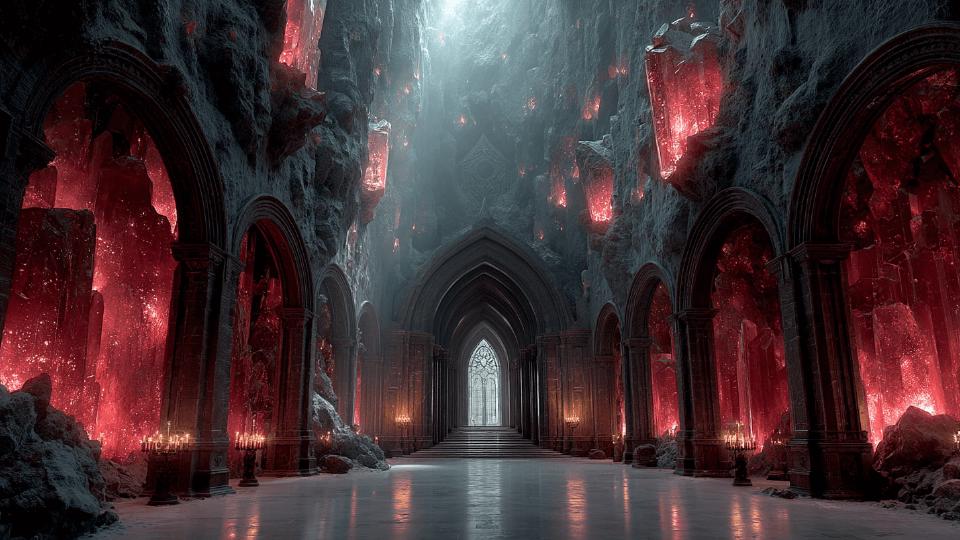
Following the unchaining of the solar plexus and the confrontation with the Daimon, a broader visionary architecture arises: the crystalline cathedral. This is the first stage. At first it appears in mixed hues, crystalline yet streaked with reddish and metallic tones. These colors are diagnostic. The red signals the sulphuric fire of the Daimon, while the metallic tones signify the imprint of astral compulsion, the lingering residue of iron chains still clinging to the vessel. What unfolds is not a static vision but the opening phase of a process, a progressive revelation of an inner temple marked by the remnants of binding and fiery distortion.
Purpose of the Cathedral
The cathedral is not merely spectacle but symbolic body and inner temple, a vessel of divine presence. In Iamblichus’ terms, it is a synthēma — a sign and a container of the sacred. Its purposes are multiple:
- To serve as the vessel in which Daimon and Nous are joined in luminous reconciliation.
- To function as the throne-hall of Nous, where intellect governs as sovereign principle.
- To rise as an axis mundi, mediating between higher and lower powers.
- To act as the vas hermeticum, the alchemical vessel in which purification and transformation are performed.
Through the cathedral, the soul perceives its own reconstituted order: destiny, intellect, and spirit aligned in a single architecture of being.
Purification of the Cathedral
The second stage is purification. The initial state of the cathedral is impure, tainted with sulphuric red and metallic stain. These tones reflect both the fiery force of the Daimon and the pressure of astral necessity upon the soul. The work is to purge these residues by the blue flame, the reconciled fire of Nous and Daimon. This flame consumes the gross without destroying the vessel, until the cathedral gleams clear and gemlike.
Final Clarification of the Cathedral
The third stage is the clarified state. The final cathedral is neither sterile whiteness nor the tainted hues of iron and sulphur, but transparent radiance: crystalline, incorruptible, and serene. It gleams with luminous clarity, the perfected form of the temple.
The Daimon’s Role Inside the Cathedral
The fourth stage is the Daimon’s re-seating. The Daimon is not expelled in this vision but re-seated, its role clarified and purified. As its grotesque mask dissolves, it is revealed as luminous minister, executor of Nous rather than tyrant of fate. The cathedral’s architecture is strengthened by this conversion: the Daimon, once jailer, becomes structural minister, a force that sustains rather than siphons. The harmony achieved here is not annihilation but integration, Daimon aligned under Nous in luminous cooperation.
Doctrinal Resonance
The crystalline cathedral resounds with Hermetic, Neoplatonic, and alchemical doctrine. Alchemy describes the Stone as crystalline, transparent, and incorruptible, echoing the qualities of this temple. The Corpus Hermeticum speaks of Nous as builder of a luminous temple within man. Iamblichus teaches that a naos is formed in the soul as dwelling place for divine presence. Zosimos of Panopolis and the Rosarium Philosophorum both liken transformation to the clarification of vessels until they hold only the pure essence. Jung later interpreted the same crystalline image as the symbol of psychic totality, the reconciliation of opposites through the coniunctio.
Thus the cathedral represents more than vision: it is the perfected inner vessel, radiant and incorruptible, in which Nous enthrones itself, Daimon ministers, and the soul perceives sovereignty revealed in luminous clarity.